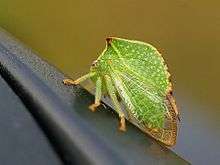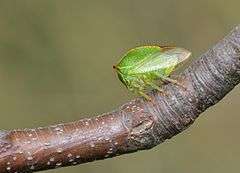Buffalo treehopper
The buffalo treehopper (Stictocephala bisonia) is a species of treehopper belonging to the subfamily Membracinae.[1] It is also sometimes classified as Ceresa bisonia.[2]
| Buffalo treehopper | |
|---|---|
 | |
| Stictocephala bisonia, side view | |
| Upperside | |
| Scientific classification | |
| Kingdom: | Animalia |
| Phylum: | Arthropoda |
| Class: | Insecta |
| Order: | Hemiptera |
| Family: | Membracidae |
| Genus: | Stictocephala |
| Species: | S. bisonia |
| Binomial name | |
| Stictocephala bisonia Kopp & Yonke, 1977 | |
Distribution
This species is native to North America, but now it is widespread throughout southern Europe and it is also present in the Near East and in North Africa.[3]
Appearance
Buffalo treehoppers are a bright green color and have a somewhat triangular shape that helps camouflage them so as to resemble thorns or a twiggy protuberance.[4][5][6] It gets its name from the vague resemblance of its profile to that of an American bison.[5] They grow to 6 to 8 millimeters (0.24 to 0.31 in) long and have transparent wings.[5][6]
Life cycle

S. bisonia mates during the summer months.[6] Males attract females with a song that, unlike similar songs used by cicada and crickets, is perceived by the female not as sound waves but as vibrations through the host plant.[7] Females lay eggs from July to October using a blade-like ovipositor.[5][6] Up to a dozen eggs are laid in each slit made by the female.[5][6]
Nymphs emerge from the eggs the following May or June.[5][6] The nymphs, which resemble wingless adults, but have a more spiny appearance, descend from the trees where they hatched to feed on grasses, weeds, and other nonwoody plants.[5][6]
They molt several times in the following month and a half until they have reached adulthood.[6] Then they return to the trees to continue their life cycle.[6]
Feeding
Both adult and immature buffalo treehoppers feed upon sap using specialized mouthparts suited for this purpose.[6] Black locust, clover, elm, goldenrod, and willow are among their favorite food sources.[6] It is also an occasional pest of fruit trees and is harmful to young orchard trees, especially apple trees.[6] It has become an invasive species in some parts of Europe.[2]
Bibliography
- Alberto Alma et al., Particularities of Polynema striaticorne as egg parasite of Stictocephala bisonia (Rhynchota: Auchenorrhyncha), 6th Auchenorrhyncha Meeting Turin, 1988, pp. 597–603.
- Arzone, C. Vidano, A. Alma Auchenorrhyncha introduced into Europe from the Nearctic region: taxonomic and phytopathological problems. Proceedings of 2nd International Workshop on Leafhoppers and Planthoppers of Economic Importance : Brigham Young University, Provo, Utah, USA, 28 July-1 August 1986: 3-17
- D. D. Kopp, Yonke, T. R., Taxonomic Status of the Buffalo Treehopper and the Name Ceresa bubalus, in Annals of the Entomological Society of America, vol. 70, no. 6, 1977, pp. 901–905
- Gabriel Simões de Andrade (1997): Stictocephala alta (Walker, 1851) sp. rev., comb. n., the Correct Name for the "Buffalo Treehopper", with S. bisonia Kopp & Yonke, 1977 as a New Synonym, and Notes on Hadrophallus bubalus (Fabricius, 1794) comb. n. (Homoptera: Membracidae). Transactions of the American Entomological Society Vol. 123, No. 4: 289-295.
- Gabriel Simões de Andrade (2008): On the synonymy of Stictocephala alta (Walker) and Thelia constans Walker (Hemiptera: Membracidae). Revista Brasileira de Zoologia 25 (1): 148–149
- P. Bovey & H. Leuzinger (1938): Présence en Suisse de Ceresa bubalus F., Membracidae nuisible d’origine américaine. Bulletin de la Société Vaudoise des sciences naturelles 60: 193–200
- W. V. Balduf: Observations on the buffalo tree-hopper Ceresa bubalus Fabr. (Membracidae, Homoptera) and the bionomics of an egg parasite, Polynema striaticorne Girault (Mymaridae, Hymenoptera). Annals of the Entomological Society of America, 1928, 21(3):419-435.
References
- Biolib
- "buffalo treehopper", Encyclopædia Britannica (Online ed.), Encyclopædia Britannica, Inc., 2008, retrieved 2008-07-14
- Fauna europaea
- John A. Jackman,Bastiaan M. Drees - A Field Guide to Common Texas Insects - Taylor Trade Publishing
- "Buffalo Treehopper". Pennsylvania Tree Fruit Production Guide. Pennsylvania State University, College of Agricultural Sciences. 2008-06-05. Retrieved 2008-07-16.
- Moran, Mark (2004-04-05). "Buffalo Treehopper: Stictocephala bisonia". Study of Northern Virginia Ecology. Fairfax County Public Schools. Archived from the original on 2008-12-20. Retrieved 2019-05-20.
- Deitz, Lewis (2011-01-18). "Sounds of Courtship, Discovery, and Defense". Treehoppers. North Carolina State University Insect Museum. Retrieved 2019-05-20.
External links
- "Stictocephala bisonia, Buffalo treehopper". 500px.com. Retrieved 2017-01-09.
- Vertdeterre (in French)
- Catalogue of life

